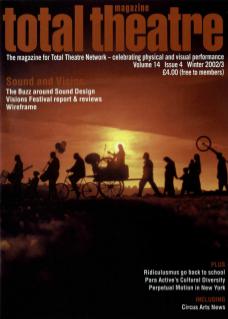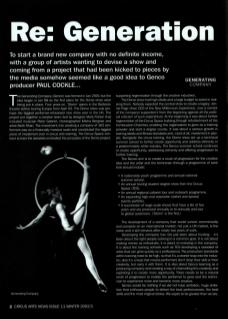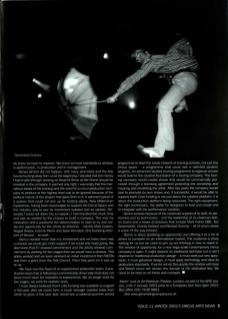The Generating Company (Genco) was formed in Jan 2001, but the idea began in Jan 98 as the first plans for the Dome show were being put in place. Four years on, Storm opens in the Barbican theatre before touring Europe from April 2003. The Dome show was perhaps the biggest performer-rehearsed new show ever in the UK. The project put together a creative team (led by designer Mark Fisher) that included musician Peter Gabriel, choreographer Micha Bergese, and artist Keith Khan. The investment into creating a company of 162 performers was on a financially massive scale and constituted the biggest piece of investment ever in circus arts training. The Circus Space contract to train the aerialists embodied the principles of the Dome project, supporting regeneration through the creative industries.
The Dome show had high ideals and a large budget to assist in realising them. Nobody expected the central show to create a legacy. Jennie Page (then CEO of the New Millennium Experience, now a mentor of the company) supported it from the beginning against all the political criticism of such expenditure. At the beginning it was about further regeneration of the Circus Space building through refurbishment of the Combustion Chamber, enabling this organisation to grow as a training provider and start a degree course. It was about a serious growth in training ideals and fitness standards and, most of all, investment in people. Alongside the circus training, the Dome show set up a technical summer school to further create opportunity and address ethnicity in a predominately white industry. The Genco summer school continues to create opportunity, addressing ethnicity and offering progression to further training.
The Genco aim is to create a route of progression for the creative idea and the artist and the technician through a programme of work that should include:
- A nationwide youth programme and annual national summer school.
- An annual touring student degree show from the Circus Space (TCS).
- An annual regional cabaret tour and outreach programme.
- An expanding high-end corporate market and special events portfolio.
- A succession of large-scale shows that have a life of five years and are produced annually or bi-annually and tour to global audiences. (Storm is the first.)
The development of a company that would survive commercially and compete on an international market, not just a UK market, is the vision and it still remains after nearly two years of work
Developing the company has not just been about funding – it's been about the right people working to a common goal. It is not about making money as individuals, it is about reinvesting in the company. It is about the training schools such as TCS developing a standard of artist that can grow quickly as a professional. The production standards within training need to be high, so that it's a shorter leap into the industry; also it's a leap that means performers don't drop their skill or their creativity, but carry it with them. It is also about Genco learning as a producing company and creating a way of channelling this creativity and exploiting it to create more opportunity. There needs to be a natural route of progression to enable the performer to grow and the technician to experience more and become more creative.
Genco would be nothing if we did not have ambition, huge ambition that enthuses people to deliver the best performances, the best skills and the most original shows. We aspire to be greater than we are, we know we have to improve. We know we have standards to achieve in performance, in production and in management.
Genco almost did not happen, with many promoters and the Arts Council turning away from us at the beginning. I decided that the money I had made through working as Head of Show at the Dome should be invested in the company. It seemed only right. I was angry that the marvellous ideals of the training and the need for a circus production company to produce at the highest level was to be ignored because of the political nature of the project that gave birth to it. It seemed typical of a system that could not join up its funding ideals. New Millennium Experience, having been encouraged to support the Circus Space and the industry, was to see its investment isolated and so wasted. Personally I could not allow this to happen; I had invested too much time and was so excited by the chance to build a company. This was my motivation and it produced the determination to start to try and create the opportunity for the artists as directors – namely Matt Costain, Abigail Yeates, Corrine Pierre and Sean Kempton (the founding directors of Genco) – to work.
Genco needed more than my investment and we knew there was a chance we would get more support if we could only keep going. We also knew that if I showed commitment and the artists showed commitment by working for low wages then we would have a chance. This policy worked and we soon received an initial investment from NESTA and then a grant from the Arts Council. From that point on it was up to us.
We have now the basis of an experienced production team. A production team that is following a commercially driven plan that does not leave much room for mistakes or experiments. We no longer work for low wages; we work for realistic ones.
I have always believed that if core funding was available to support a five-year plan we could form a much stronger creative base from which to grow. A five-year plan would see a national summer school programme to feed the whole network of training schools, not just the Circus space – a programme that could see a talented student progress. An advanced student touring programme to regional venues would lead to the creative foundation of a touring company. This touring company would create shows that would be commercially promoted through a licensing agreement protecting the ownership of and inspiring and rewarding the artist. After five years the company would plan to promote its own shows and, if successful, it would be able to support itself. Core funding is not just about the creative platform, it is about the production platform being resourced. The right equipment, the right technicians, the ability for designers to lead and create and to integrate with the performance creation.
Genco survives because of the continued support of its staff, its performers and its technicians – and the leadership of its chairman Adrian Evans and a board of directors that include Mark Fisher OBE, Teo Greenstreet, Charlie Holland and Richard Sumray – all of whom share a vision of the way forward.
Genco is about grabbing an opportunity and offering it to a lot of artists to compete on an international market. The audience is there waiting for us but we need to join up our thinking in how to reach it. The window of opportunity for a new large-scale contemporary circus company is open. It might depend on traditional skill base but it can't depend on traditional production design – it must seek out new spectacle, it must galvanise design, it must apply technology and raise its production standards. If we do not do this quickly the window will close and British circus will remain the domain of the dedicated few. We need to be bold on all fronts and compete.
Storm runs at the Barbican Theatre, London, as part of the BITE season, until 4 January 2003 prior to a European tour from April 2003. See www.generatingcompany.co.uk


